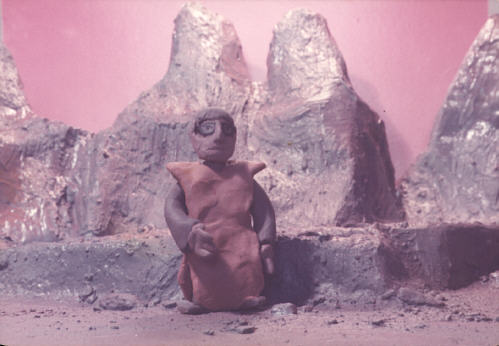The Klingon set fully lit. Slightly visible over the captain's shoulder is a "We
Love Darth Vader" poster.
|
The Klingon set with mood lighting. Beneath the captain's seat would be an illuminated
base of blue light.
|
The Klingon viewscreen, like it's counterpart on the Fulton's Folly, would have
display space footage or whatever the scene required.
|
To save room, the Space Station K Mart set shared the same area as the Klingon
bridge. The walls slid into the vertical grey supports behind the gent at the desk.
|
The boss gets a new desk. The other belonged to the Space Office transporter. View
of another part of Space Station K Mart visible through the window.
|
As mentioned earlier, I wasn't too pleased with the Vulcan set and extended the
size of the mountains and coated the surface with hydrocal for that rocky look.
|
|

Mr. Specks in front of the larger Vulcan mountains.
|
Mr. Specks and T'Lard on Vulcan. He almost earned his Logic T-Shirt.
|
Admiral Bullthrower's office contained artwork from Star Trek model boxes.
|
At left, a fragment of non-Star Trek artwork came from Paul McCartney's VENUS AND
MARS album.
|
Klurk is visiting an Egyptian museum when he's summoned to Starfleet. A golden
Darth Vader is on display.
|
An old style shuttle craft was used as transportation to Starfleet. A
McDonald's ice cream cup served as a futuristic building in the background.
|
Kathy Baumgarten, Martin's wife, painted the watercolor background that provides
the view of San Francisco Bay outside of Starfleet headquarters.
|
The shuttle has landed on the Starfleet set. A foreground balcony was added for
Klurk to discuss his plans with Commander Sonar.
|
After his meeting with the admiral, Klurk beams up to the orbiting space office
and meets Mr.Scotch.
|
The travel pod interior could be butted against any other set so when the doors
opened it would appear to have docked with the ship or space office.
|
Klurk strolls around the corridor outside the transporter room.
|
More crew members stroll the corridor. The travel pod deck was docked to this when
Klurk arrives on board.
|
The viewscreen half of the bridge also contained the security and weapons console.
|
The engineering section contained two consoles to monitor flow of power throughout
the ship.
|
Since the tube was supposed to be several decks high, the set was elevated to allow
this and to hide the wires powering the fluorescent bulbs.
|
We've got power! Grant's fluorescent tube does the trick. We expected it to flicker
during the animation but it stayed steady. We hoped a flicker would to add an illusion of functioning energy.
|
This almost colorless corridor prompted me to make some changes to snaz it up.
|
The rear wall was redesigned with a backlit panel, darker blue on the upper panel and
a sign. The metal grey door was painted orange.
|
The transporter in Star Trek: The Motion Picture was given a protective wall between
the operator and the pads as protection from the device's radiation.
|
Thanks to Grant, the transporter pads could now light up. The "Watch Your Step"
gag from the original films was carried over.
|
Klurk explains the mission on the rec deck. When it was fully manned, it required
both Grant and I to animate all the characters.
|
The back wall to the rec deck. The 1970's bridge crew portrait is barely visible
behind the characters on the lower level.
|
